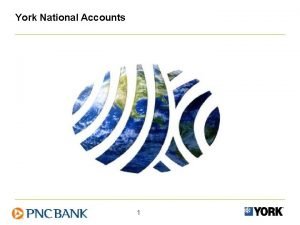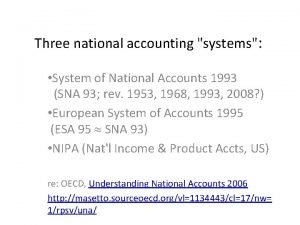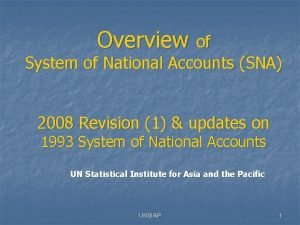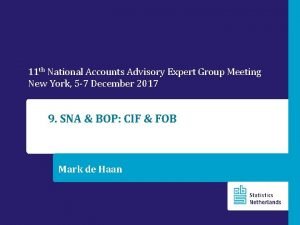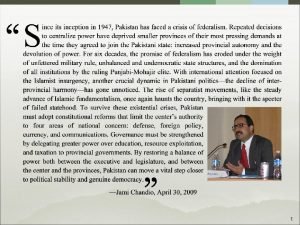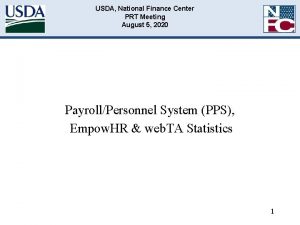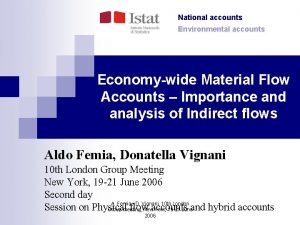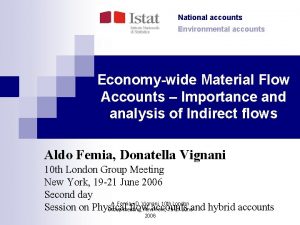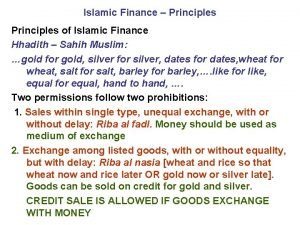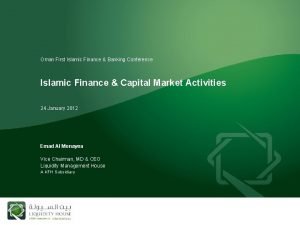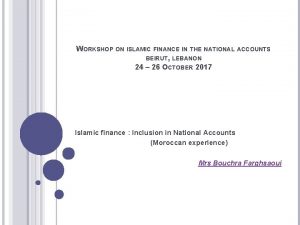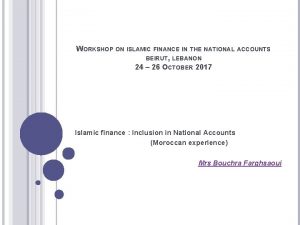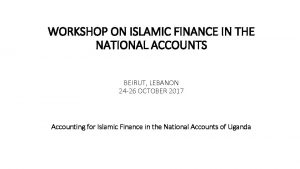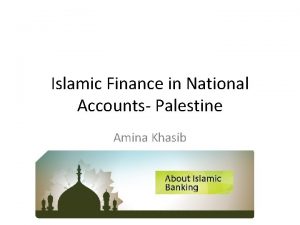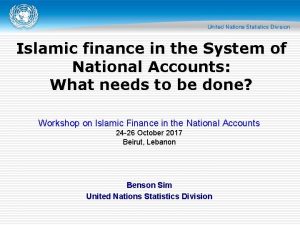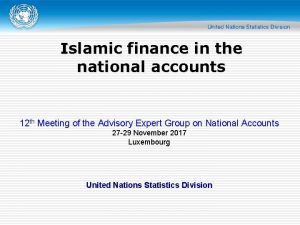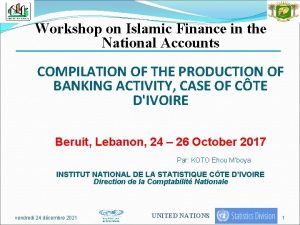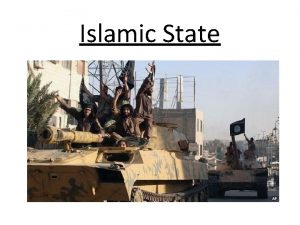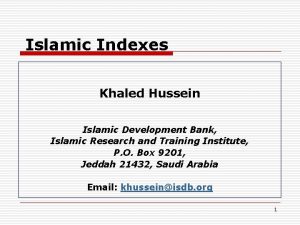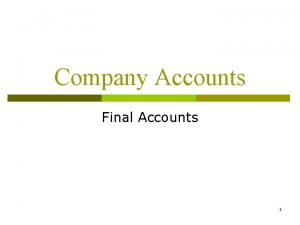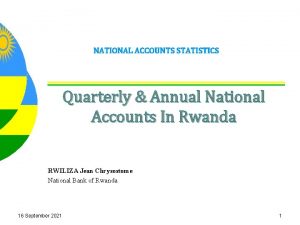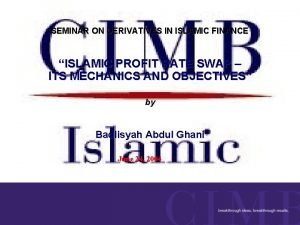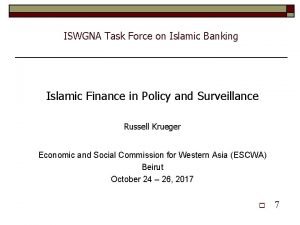Islamic finance in the national accounts 11 th

























- Slides: 25

Islamic finance in the national accounts 11 th Meeting of the Advisory Expert Group on National Accounts 5 -7 December 2017 New York, United States of America Benson Sim United Nations Statistics Division

Outline of presentation § § § § Background What has been done Discussions at Beirut workshop Key conclusions of Beirut workshop Key recommendations of Beirut workshop Looking ahead Questions for the AEG 2

Background § § Islamic finance does not operate in the same way as conventional finance as it follows the Shari’ah Islamic law, principles and rules Shari’ah Islamic law does not permit • • § § Receipt and payment of “riba” (interest) Gharar (excessive uncertainty) Maysir (gambling) Short sales or financing activities that it considers harmful to society Instead, the parties must share the risks and rewards of a business transaction The transaction should have a real economic purpose without undue speculation, and not involve any exploitation of either party 3

Background Example of difference Traditional Bank (Automobile Loan) Automobile Loan Bank (Lends 100% to Client) Client (Monthly Installment P+ i & Has Title Deed) Asset Based approach • Money on money interest approach as Bank does not buy an asset to resell • Installment has an interest component • Return on money is interest (on money) as no asset resale will happen • This is clearly not an asset-backed approach to financing 4

Background Example of difference Murabaha (Automobile Financing) Bank (Financier) 1. $10000 Cost Price (spot) 2. Assets (spot) 3. Assets (spot) 4. $11000 Sale Price (deferred payment sold at retail + $1000 agreed margin) Market Cost-Plus approach: • • • Client (Borrower ? ? ? ) Recorded at $11, 000 5. Assets (spot) 6. $10000 Cost Price (spot) Market Terms are fixed from the outset of the agreement (in particular value of payment) In the event of early termination, no discount applied for early settlement Rebate on the deferred sale price permitted, but at the discretion of the financier

Background § § Issues on the implementation of the 2008 SNA recommendations for Islamic finance were raised during several meetings in the Arab region organized by ESCWA The Advisory Expert Group (AEG) on National Accounts discussed this issue at its 10 th meeting and • • • § Noted the differences in business arrangements between Islamic finance and conventional finance Recognized the system importance of Islamic finance for some economies and their relative rapid growth Agreed that further research on the statistical implications of Islamic finance in the national accounts is required and that practical guidance on the treatment of Islamic finance transactions needs to be developed A task force was thus created with the aim to address the statistical treatment of Islamic finance in the national accounts 6

What has been done § § § A Web. Ex meeting among key stakeholders to identify key areas of work was organized in June 2017 Islamic finance website to consolidate relevant materials and provide updates on the work done has been set up (see https: //unstats. un. org/unsd/nationalaccount/ud. IF. asp) A Workshop on Islamic Finance in the National Accounts was organized in Beirut, Lebanon, from 24 -26 October 2017 7

Discussions at Beirut workshop § Workshop saw • Presentations and draft recommendations on q q q q § Use of income statements and balance sheets of Islamic banks for compiling national accounts Sectorization of Islamic financial corporations Classification of Islamic financial instruments Classification of corresponding property income associated with Islamic financial instruments Calculation of output and value added of Islamic financial services International initiatives to collect data on Islamic finance Country practices in compiling Islamic finance statistics, challenges involved and solutions to overcome these challenges Workshop resulted in a number of key conclusions and recommendations 8

Key conclusions Relevance of the 2008 SNA framework § § The 2008 SNA provides the overarching integrating framework to measure the activities of Islamic finance The accompanying international classification schemes such as ISIC Rev. 4 and CPC Ver. 2. 1 are meant to provide general guidance and recommendations Thus, they should not be amended to specifically accommodate the various elements of Islamic finance Rather, compiling agencies can consider disaggregating the relevant categories in international classification schemes to the relevant Islamic finance sub-categories in the national reporting of data 9

Key conclusions Use of income statements and balance sheets of Islamic banks § § There are important differences between the income statements and balance sheets of Islamic banks and conventional banks A thorough understanding of these differences is needed to determine how to use the income statements and balance sheets of Islamic banks in the compilation of national accounts The Islamic bank framework of the IFSB potentially provides a good source of information for compiling Islamic finance statistics in the national accounts There is a need to determine whether Islamic banks or its clients are the economic owners of the non-financial assets related to sales, lease and equity financing which are reported on the balance sheets of Islamic banks 10

Key conclusions Use of income statements and balance sheets of Islamic banks § § There is a need for worked examples to illustrate how to make use of these income statements and balance sheets to calculate the various elements of Islamic finance such as property income and output in the national accounts Solutions to obtain separate data on Islamic windows need to be developed as such data are typically not collected by regulatory or supervisory authorities 11

Key conclusions Sectorization of Islamic financial corporations § § § Islamic financial corporations can be allocated to the subsectors of the financial corporations sector as outlined in the 2008 SNA However, the allocation of Islamic financial corporations to the deposit-taking corporations except the central bank subsector will need to be reconciled with the consequent classification of at least one of their financial instruments on the liabilities side as deposits and the corresponding property income payable as interest Sovereign wealth funds if they are institutional units and provide financial services on a market basis to the government are allocated to the captive financial institutions and moneylenders subsector 12

Key conclusions Sectorization of Islamic financial corporations § Islamic insurance corporations should be allocated to the insurance subsector given that the nature of their economic activity is no different from that of conventional insurance corporations 13

Key conclusions Classification of Islamic financial instruments § § The existing sectorization of Islamic financial corporations and classification of Islamic financial instruments for compiling monetary and financial statistics using the classification schemes in the 2008 SNA are intended to obtain major macroeconomic aggregate indicators such as money supply (broad money) and credit There is a need to reconcile the existing sectorization and classification with the perceptible shift to second era Islamic finance such as profit and loss sharing accounts, Islamic financial instruments with hybrid features and the classification of the associated property income in the national accounts 14

Key conclusions Classification of Islamic financial instruments § The reconciliation exercise will also need to assess the impact on the measurement of debt and money supply arising from classifying Islamic financial instruments as equity and non-equity in the 2008 SNA framework 15

Key conclusions Classification of corresponding property income § § There is a need to assess whether the current concept of interest in the 2008 SNA can be interpreted to include the property income associated with Islamic financial instruments that are classified as deposits, loans or debt securities There is a need to reconcile the classification of the investment income payable to holders of unrestricted profit-sharing investment accounts and the subsequent reinvestment of a portion of this investment income in the profit equalization reserves 16

Key conclusions Output and value added of Islamic financial services § § § There is a need to assess whether it is appropriate to calculate the output of the financial intermediation services provided by Islamic financial corporations which are classified as deposit-taking corporations using the FISIM formula, and if yes, determine the appropriate reference and financing rates to be used in the calculation of these services There is a need to develop practical guidance on how to calculate the quarterly output of Islamic financial services whose returns are only known ex-post annually There is a need to develop methods to estimate the intermediate consumption of Islamic financial corporations and Islamic windows in order to calculate their value added 17

Key conclusions International initiatives to collect data on Islamic finance § § § There is a need for regional and international organizations which are collecting data on Islamic finance to explore collaborative efforts in order to reduce duplication and respondent burden Links to the databases of these international organizations should be included on UNSD’s Islamic finance website to enhance user accessibility to the data which are collected There is a need for regional and international organizations which are collecting data on Islamic finance to consider standardizing their data collection and dissemination methods using internationallyendorsed standards such as Statistical Data and Metadata e. Xchange (SDMX) protocols 18

Key recommendations § § Two working groups should be formed to streamline the work to tackle the issues which were raised during the workshop First working group will work on • • • Use of income statements and balance sheets of Islamic banks for compiling national accounts Sectorization of Islamic financial corporations Classification of Islamic financial instruments Classification of the corresponding property income associated with Islamic financial instruments Calculation of output and value added of Islamic financial services 19

Key recommendations § A corporation-by-corporation and instrument-byinstrument analysis of the characteristics of Islamic financial corporations and Islamic financial instruments and their transactions will be summarized in a matrix in order to determine the • • Appropriate sectorization of Islamic financial corporations Classification of Islamic financial instruments Recording of these transactions in the integrated national accounts framework Development of a standard questionnaire to collect the input data 20

Key recommendations § Second working group will • • • Assess how to coordinate the work of regional and international organizations which are collecting data on Islamic finance to maximize synergies and minimize duplication and respondent burden Assess the data can be used to compile Islamic finance statistics in the national accounts Explore how to standardize their data collection and dissemination methods using internationally-endorsed standards such as SDMX protocols 21

Key recommendations § § § The two working groups should coordinate their activities to ensure the development of recommendations in an integrated approach The development of recommendations and guidance of these two working groups should include inputs from stakeholders including central banks, compilers of monetary and financial statistics, regulatory and supervisory authorities, Islamic accounting standards setting agencies and practitioners in the Islamic finance industry These stakeholders be invited to future workshops if they are organized 22

Looking ahead § § § Discussion on composition of two working groups will start in January 2018 Timeline of activities of two working groups will be determined once they are formed Outcomes of work of the two working groups will be reported at future AEG meeting 23

Questions for the AEG § The AEG is requested to provide guidance on the key recommendations presented in paragraphs 28 -32 of the paper 24

Thank you 25
 Habib
Habib Derivatives in islamic finance
Derivatives in islamic finance York national accounts
York national accounts The national income and product accounts
The national income and product accounts National account systems
National account systems Sna 2008
Sna 2008 Advisory expert group on national accounts
Advisory expert group on national accounts National finance commission
National finance commission National finance commission
National finance commission National finance center
National finance center Davis contractors v fareham udc
Davis contractors v fareham udc Hình ảnh bộ gõ cơ thể búng tay
Hình ảnh bộ gõ cơ thể búng tay Ng-html
Ng-html Bổ thể
Bổ thể Tỉ lệ cơ thể trẻ em
Tỉ lệ cơ thể trẻ em Gấu đi như thế nào
Gấu đi như thế nào Tư thế worms-breton
Tư thế worms-breton Alleluia hat len nguoi oi
Alleluia hat len nguoi oi Các môn thể thao bắt đầu bằng tiếng đua
Các môn thể thao bắt đầu bằng tiếng đua Thế nào là hệ số cao nhất
Thế nào là hệ số cao nhất Các châu lục và đại dương trên thế giới
Các châu lục và đại dương trên thế giới Công của trọng lực
Công của trọng lực Trời xanh đây là của chúng ta thể thơ
Trời xanh đây là của chúng ta thể thơ Cách giải mật thư tọa độ
Cách giải mật thư tọa độ 101012 bằng
101012 bằng Phản ứng thế ankan
Phản ứng thế ankan


